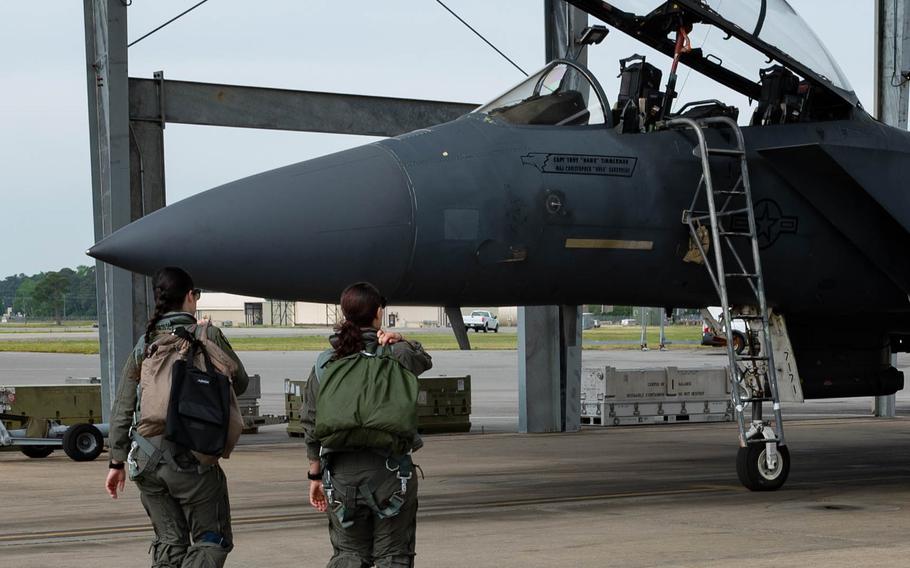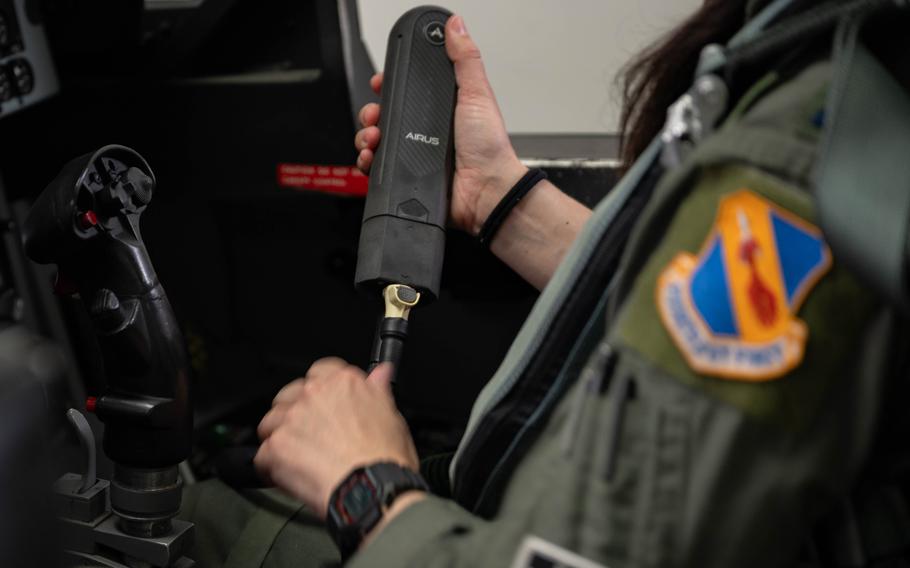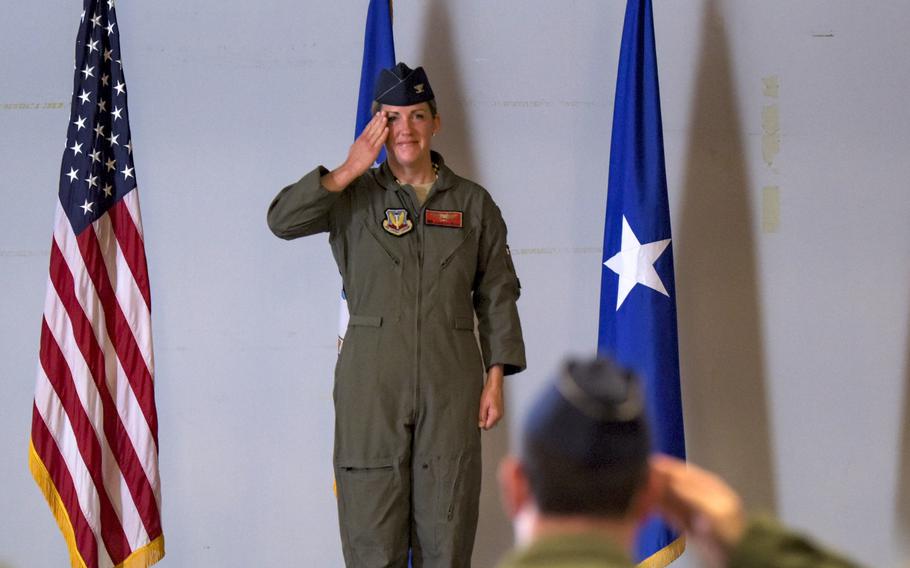
Two female pilots prepare to flight test the AIRUS system at Seymour Johnson Air Force Base, N.C. (U.S. Air Force photo)
During more than a century of manned flight, a nagging problem has been how to answer nature’s call when up in the wild blue yonder.
Modern fighter jets such as the F-15 Eagle top out at more than 1,900 miles per hour, though the technology for bladder relief for single and dual-seat aircraft pilots strapped into an ejector seat has lagged.
The problem is a bigger challenge for a growing segment of Air Force flight crews — the 118 female fighter pilots in jets such as the F-15 Eagle, F-16 Fighting Falcon, F-22 Raptor, F-35 Lightning II and A-10 Thunderbolt II, as well as female weapons systems operators flying in two-seat variants.

Air Force airman connects the AIRUS in-flight bladder relief system at Seymour Johnson Air Force Base, N.C., in 2024. (Airman 1st Class Rebecca Sirimar)
“I’ve flown sorties where I end up covered in my own urine,” said Capt. Madeleine Poisson, a F-15 weapons system officer with the 48th Wing based in England.
Prior to January, options for female pilots and weapons system operators for bladder relief in aircraft included adult diapers and a “piddle pack” sleeve that required unstrapping from the seat, unzipping the lower part of their uniform, and applying a synthetic sock-like funnel to their body.
There was also a pump system that was not suited to women compared to the men, for whom it was designed.
Along with the discomfort of “flying wet,” at least two crashes — both involving male pilots — in the past three decades have been linked to faulty systems or pilot error while attempting in-flight relief, according to the Air Force.
But male and female pilots have some relief arriving with a new system developed under the “Sky High Relief Challenge” issued by AFWERX, the service’s idea incubator program based at Wright-Patterson Air Force Base in Ohio.
The program tries to solve key issues at an accelerated timetable compared to the sometimes glacial pace of normal military procurement. Instead of years, ideas can get approved in as little as six months.
For the challenge, the directive was to come up with something better suited for female flight crews then the diapers, piddle pack or pump.
From more than 50 submissions in 2020, the Air Force narrowed the field of solutions to 24, then chose 11 companies to receive $1.5 million in design prizes to advance their ideas.
“It’s energizing and inspiring to see how government, industry, and academia come together to roll up their sleeves and dive deep into problem solving,” said Cayley Dymond, the AFWERX challenge program leader.
The Air Force settled in 2021 on the idea from Airion Health, a Los Angeles start-up company, to prototype its solution to the challenge.
The winning idea essentially reverse-engineered the bladder relief problem, coming up with what the Air Force termed a “biocompatible” system that could be used by female flight crews, then adapting it to male pilots as well.

Air Force Col. Samantha Weeks renders a final salute during a change of command ceremony in 2018 at Nellis Air Force Base in Nevada. Weeks is now retired from the service. (U.S. Air Force photo)
Airion’s final product was named the Advanced Inflight Relief Universal System, or AIRUS.
It’s a form-fitting, self-cleaning underwear system using a small pump with soft tubing that directs waste to a custom-made “biofluid” bag. Pilots control the system with a remote hand controller and simply unplug the bag from the tubing at the end of missions for disposal.
Airion co-founder Colt Seman, who worked in the baby product industry, said bringing a female perspective to the project from the start would be a key to winning the challenge.
“We knew it was imperative to assemble a design team of women, including medical professionals, pilots, and flight engineers,” Seman said. “AIRUS is a product designed by women, for women.”
Full system development started in March 2022 after an initial $2.5 million contract was awarded to Airion Health by the Air Force.
After testing in 2023, flights with female flight crews in F-15s at Seymour Johnson Air Force Base in North Carolina began in 2024. The last tweaks to the AIRUS design wrapped up in November, and the final version of the system was ready in January.
The AIRUS system is available for purchase by squadrons via the General Services Administration website. The base price is about $4,000 per kit, which are requisitioned by squadrons for the pilots and flight officers.
The primary challenge centered on a system that could be used by women, and there are multiple-sized cup attachments for different female body types. But the system also offers two variants built for the male anatomy as well.
“Through the end of April, about 50 AIRUS units have been deployed and more than 100 are in the pipeline,” said Matthew Clouse, an AFWERX spokesman at Wright-Patterson AFB. “Orders are coming in for both males and females in units.”
The cost to date of developing and fielding AIRUS is about $4.5 million, Clouse said.
The Pentagon also plans to adapt the system for use by Navy and Marine jet pilots, along with Army helicopter crews. Eventually, the system could be sold to allied nations.
Retired Air Force Col. Samantha Weeks graduated from the U.S. Air Force Academy in Colorado in 1993 and logged 2,200 flying hours in F-15Cs, F-16s and T-38 Talons — including 105 combat hours enforcing “no-fly zones” in the Middle East. She was the first woman to command an F-16 fighter wing and flew the key “solo slot” with the Air Force’s elite Thunderbirds aerial demonstration team.
Weeks said she has been involved since 2000 in Defense Department efforts to advance flight equipment for female pilots. In 2018, she made a video about how to choose and use a piddle pack.
“At times, there were females at wings or in squadrons who didn’t have someone to ask how does this work, what do I do, where can your purchase this type of flight suit, or this brand of piddle pack,” she said.
Weeks retired from the Air Force in 2020 but remains involved in the Defense Department efforts to improve equipment for female aircrews. She hopes AIRUS will cut back on the longtime practice of pilots — particularly women — simply avoiding fluids before flying.
“Tactical dehydration - I hate this term,” Weeks said. “Any person saying they “tactically dehydrate” not to urinate is really just reducing their physical and cognitive abilities, and that has no place in combat.”
Air Force studies have shown the practice puts a pilot’s physical and mental wellbeing at risk. Air Force researchers have found being dehydrated can cut a pilot’s ability to tolerate gravitational force by as much as half. The lower tolerance can cause pilots to experience “G-induced Loss of Consciousness” — known as GLOC.
The lack of liquids can also cause vertigo-like loss of situational awareness, blurred vision, memory lapses, and headaches. Pilots who dehydrate repeatedly during their career can develop kidney problems, urinary infections, and suffer from long-term incontinence.
The issues have become more pressing as military aviation has advanced with long-range missions using in-flight refueling that can keep the pilot of a fighter or attack aircraft in the air for up to 16 hours, the Air Force said.
“I am glad to see AIRUS hit the market,” Weeks said. “I hope other needs for proper fitting equipment for women continues to have support.”
She said the anthropometric data — measurements for the size, shape, and weight of pilot and flight officer equipment — is based on a 1967 study using only men. Revisions since 2008 have updated some of the gear.
AIRUS is part of finding solutions for female pilots that can also benefit male pilots — a crucial step in meeting pilot recruiting goals and aiding in the national defense.
“Expedient production of female aviator gear initiatives will maximize the combat lethality and readiness of all military services,” Weeks said.
Poisson, the F-15 weapons system officer, is a happy early adopter of the AIRUS system.
“Oh, I love it,” she said. “Hands down, the best system that I’ve seen. I can leave it in while flying, it’s relatively comfortable, and you have the ability to put it in and take it out while flying. There’s no decrease in my capabilities during the mission.”